 |
Jared searching for the rattlesnake; he eventually found it in the bushes in the bottom left-hand corner of the photo.
|
 |
| The well-camouflaged rattlesnake extending its long black tongue; Jared's photo |
At noon, we went off route a mile or two to eat lunch at a ranch called Arena Los 500 Novillos (Novillos = steers). Adrian knew the owners, so the small adobe walled building opened just for us turista. We were quickly served a hot, delicious Mexican lunch cooked in an undersized kitchen. A small boy served each platter handling it deftly and charming all of us. I gave him a dollar tip as did several others. Adrian explained that Mexicans are paid a daily rather than an hourly rate, the average rate equivalent to $3 a day. This, he explained was why so many wanted to work in the U.S. to support themselves and their families. (This reminds me that in Mexico the symbol for peso is $, our dollar sign, or at least the one this computer uses with one line through it. The exchange rate while we were in Mexico was 1 peso = 0.056 dollar or about 17 pesos to the dollar.)

 |
| Adrian, me, Jared, and our bus driver Eloi |
 |
| Sarene Rosen led by Jonathan entering the ranch house where we were served lunch |
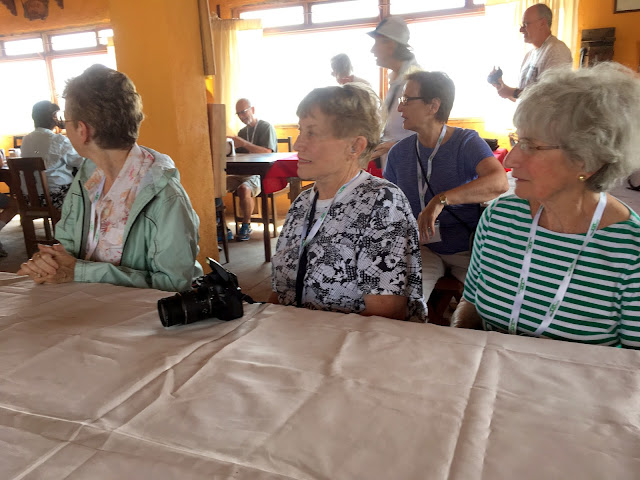 |
| My roommate, Nancy; Joan McEachern, and Sarene at the lunch table; Cynthia Decamp in blue tee. Joan and Sarene were from the Chicago area and were traveling together, Joan always with her camera at the ready. I hope she sends some of her best shots to us participants. |
Much of our tour was a Mexican history lesson. Adrian explained that Mexico’s official name is the United Mexico States, something I did not know. Mexico is divided into 31 federal states and Mexico City, a federal district with a level of autonomy comparable to that of a state, but not a state itself. Somewhat like our 50 states and Washington D.C. Click on this link to see if you can locate each state on a map of Mexico: https://online.seterra.com/en/vgp/3078
 All along the route, and each time we entered a city, there were large commemorative statues and obelisks in the center of roundabouts or at the side of the road. Many were for occasions or persons in Mexico’s War of Independence (Día de la Independencia), which, BTW, was being celebrated on the weekend the tour ended—although flags colored red, white, and green and decorations were up and some people had begun to celebrate early. Mexico celebrates Independence Day on September 16, the day Miguel Hidalgo is thought to have made the “cry of independence” (El Grito de la Independencia) in the town of Dolores, in Guanajuato state.
All along the route, and each time we entered a city, there were large commemorative statues and obelisks in the center of roundabouts or at the side of the road. Many were for occasions or persons in Mexico’s War of Independence (Día de la Independencia), which, BTW, was being celebrated on the weekend the tour ended—although flags colored red, white, and green and decorations were up and some people had begun to celebrate early. Mexico celebrates Independence Day on September 16, the day Miguel Hidalgo is thought to have made the “cry of independence” (El Grito de la Independencia) in the town of Dolores, in Guanajuato state.
Hidalgo was one of the nation’s leaders during the country’s War of Independence. His speech was made on September 16, 1810 to motivate people to revolt against the Spanish regime. Hidalgo’s army fought against the Spanish soldiers in the fight for independence, but Hidalgo was captured and executed on July 30, 1811 not a year after his call to arms. Mexico's independence from Spain was not declared until September 28, 1821, 11 years after el Grito and 45 years after the U.S. had won its independence from Great Britain.
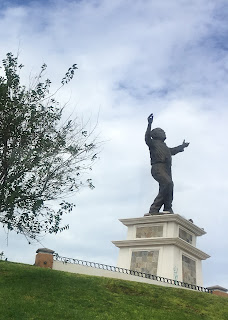 |
| Statue of Anthony Quinn |
One roadside statue, had nothing to do with the Mexican Revolution. Surprisingly, it was a statue of Anthony Quinn. Though many think of Quinn as Greek due to his role in Zorba the Greek, Antonio Rodolfo Quinn Oaxaca, more commonly known as Anthony Quinn, was Mexican-American, born in Chihuahua, Mexico, and growing up first in El Paso, TX, and then in Los Angeles. His father rode with Poncho Villa.
When we arrived in Chihuahua, Adrian’s home city, he pointed out small, white stucco government-built houses, each with a large black water tank on its flat roof. Adrian and his family of five live in one of these houses. He explained that they were affordable because they are bought on government loan and the government takes a portion of the dweller's monthly wages in payment. Adrian explained that once the homeowners had lived in the house for 25 years or so, they had paid off the mortgage and the house was theirs to pass on to their heirs. The first of these government houses to be built, the type that Adrian and his family live in, were single-story and very tiny (see below), all massed together on a plot of city land. Adrian joked about having one foot in the front door and the other out the back door, but he pointed out a hillside of newer, more spacious, versions of two stories. I could not get a photo from the bus, and could find only the photo below of an uncompleted group of these houses (no black rooftop water tanks).
After we toured this 300-year old city, once the capital city of Mexico, we were put up in the Quality Inn Chihuahua San Francisco, very American feeling in every way.
Before settling at the QI, we first visited the Historical Museum of the Revolution, former private home of Pancho Villa, born José Doroteo Arango Arámbula, and his wife Maria Luz Corral de Villa. The Villa house was elaborate and contained more than 50 rooms. Where did Villa get the money to build such an estate? Well, we learned that he was the consummate showman who understood the importance of good press, financing, and leadership. He forced assessments on hacienda owners, robbed trains and banks, held people hostage, and in 1913 when he was governor of Chihuahua, he printed money. For a fee he even allowed journalists to accompany him on the battlefield, and for 50% of the profits, he allowed Hollywood to film his war tactics.
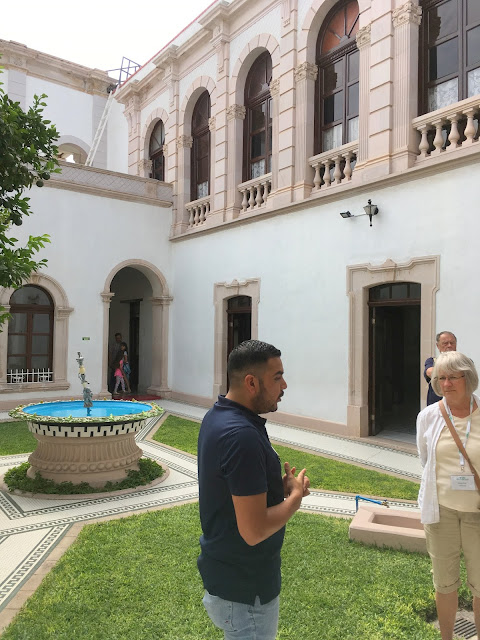 |
Adrian in one of the courtyards at the Historical Museum of the Revolution,
formerly Pancho Villa's private home
|
 |
| The tiled walkways and trompe l'oeil walls of the museum's inner courtyard |
 |
| Another inner courtyard showing the second floor of the museum |
Though the Mexican Revolution was “a sweeping panoply of brutal battles, criminal adventure, and treacherous savagery,” Gen. Francisco (Pancho) Villa, for all his murdering ruthlessness and outlaw reputation, is today considered a hero of the Mexican Revolution. Statues, plaques, photos, and revolutionary sites abound.
 |
We were not allowed to take photos anywhere but in the courtyards,
so this is the best I could do of this mural of Villa and, I think, Emilliano Zapata
|

 In 1923, Villa was assassinated in his Dodge Brothers touring car (photo right and below) in Parral, Chihuahua, leaving 31-year-old Luz Villa a widow—and with an orphanage on their property of some 50 children of all ages, five or six the result of her husband’s extramarital activities. (Villa’s “exuberant machismo” claimed at least 26 women as “wife” during his lifetime but he was only legally married in the Catholic Church to Luz.) However, until her death in 1981, Luz celebrated her husband’s legacy—and her own celebrity—by turning her 50-room mansion into the Villa Museum. Ironically, today the Mexican military owns the property and the Historical Museum of the Revolution.
In 1923, Villa was assassinated in his Dodge Brothers touring car (photo right and below) in Parral, Chihuahua, leaving 31-year-old Luz Villa a widow—and with an orphanage on their property of some 50 children of all ages, five or six the result of her husband’s extramarital activities. (Villa’s “exuberant machismo” claimed at least 26 women as “wife” during his lifetime but he was only legally married in the Catholic Church to Luz.) However, until her death in 1981, Luz celebrated her husband’s legacy—and her own celebrity—by turning her 50-room mansion into the Villa Museum. Ironically, today the Mexican military owns the property and the Historical Museum of the Revolution.
Next we stopped at the Government Palace. Adrian explained that Mexicans loved fiestas (celebrations) and were gearing up for Independence Day . . . and Sweet 15 fiestas. We arrived at the Government Palace simultaneously with a Sweet 15 party that arrived in a stretch limo. The Sweet 15ers like to be photographed in the Palace courtyard, as the photos below attest. Can you believe that these young women are only 15? Each dressed in a beautiful gown. Before getting to the palace we were on a street of shops selling elaborate gowns of every style and color. Adrian told us that the gowns were very expensive (he has a 13-year-old daughter and is already beginning to wince at the approaching outlay) and are not recycled through next-to-new shops like our Sweet 16 and prom gowns, thus a few of the girls wear the gown their mother wore to her Sweet 15 celebration. The young boys in the party dress in cowboy-style matching outfits.
 |
| Sweet 15 partiers posing for photos in the Palace courtyard; note the murals covering the first floor walls; Internet photo |
 |
| Young wannabes learning the ropes |
Sweet 15 partiers aside, Adrian explained the magnificent murals in the Government Palace, painted over a period of several years by Muralist Aarón Piña Mora. One mural showed the death of Hildago and another honored liberators Abraham Lincoln, Benito Juárez, and Simón Bolivar.
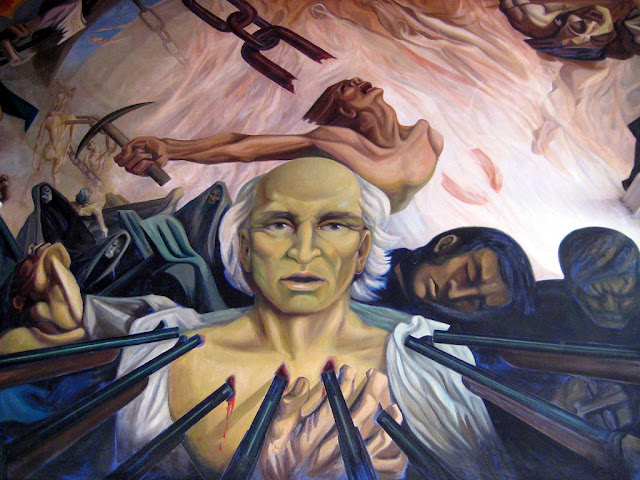 |
| The death of Hildago |
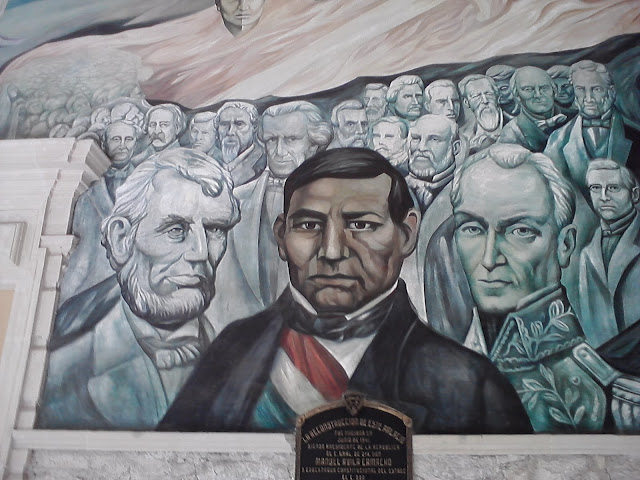 |
| Abraham Lincoln, Benito Juárez, and Simón Bolivar |
Next we visited a baroque cathedral dedicated to St. Francis of Assisi. Some young people were performing a Danza Christo Rey outside the cathedral and I photographed them but when I saw the pix I was more delighted by the painted children's faces among the onlookers (photo below).
Sunday, Sept 10
Copper Canyon
Departing Chihuahua after breakfast I sat back and enjoyed the mountains, flower filled fields, pecan and apple orchards, valleys, rock formations, and small towns flashing by the bus window as we climbed from mesquite to yellow flowered roadside and fields, to pine-filled valleys and mountains, and eventually to Divisadero on the rim of the canyon. Often there were shrines, some of them quite elaborate, and also flower bedecked crosses to indicate where someone had died in a car accident. I even saw one ghost bike, a bike painted white and affixed beside the road to indicate where a cyclist had been killed. We have the crosses and ghost bike customs in the U.S., too. All but the Internet flower pix below were taken through the bus window.

 On the bus trip up to the hotel, Jared and I worked hard to identify the yellow flowers that filled the fields and lined the roadsides. It was close to impossible from the bus, but I picked a sample when we got to Divisadero, and we found the flower in one of Adrian's booklets. No scientific name, just a descriptor, something like "golden button flower" next to a photo of an "Unnamed Flower." I am nothing if not persistent, however, so tracked it down as possibly being one of two flowers: Tansy (Tanacetum vulgare) or Pericome (Pericome caudata). Both flowers are perennials of the aster family. Though beautiful along the roadsides,Tansy, an invasive herb, is poisonous, and is often used as a natural bug repellent. Pericome is descrbed on my Wildflower app as "a common late season wildflower along mountain road banks." Pericome was called Yerba de Chivato (the herb of the he-goat) by early Spaniards because of its odor. The sample I picked did not seem to have a strong odor, so maybe neither of these flowers is the one we were seeing so profusely along the roadside, though my money is still on Tansy.
On the bus trip up to the hotel, Jared and I worked hard to identify the yellow flowers that filled the fields and lined the roadsides. It was close to impossible from the bus, but I picked a sample when we got to Divisadero, and we found the flower in one of Adrian's booklets. No scientific name, just a descriptor, something like "golden button flower" next to a photo of an "Unnamed Flower." I am nothing if not persistent, however, so tracked it down as possibly being one of two flowers: Tansy (Tanacetum vulgare) or Pericome (Pericome caudata). Both flowers are perennials of the aster family. Though beautiful along the roadsides,Tansy, an invasive herb, is poisonous, and is often used as a natural bug repellent. Pericome is descrbed on my Wildflower app as "a common late season wildflower along mountain road banks." Pericome was called Yerba de Chivato (the herb of the he-goat) by early Spaniards because of its odor. The sample I picked did not seem to have a strong odor, so maybe neither of these flowers is the one we were seeing so profusely along the roadside, though my money is still on Tansy.





Finally we arrived in Divisadero (the viewpoint) and our Hotel Divisadero Barrancas 7,310 feet above sea level. Here we could hardly walk to our high cliffside rooms for gawking into the canyons that make up Copper Canyon National Park (Parque Nacional Barranca del Cobre) and seeing the canyon floor over 6,000 feet (over 1 mile) below. Copper Canyon is a pristine wilderness four times the size of the Grand Canyon and quite different because its upper alpine slopes are green with pines, and oak. Adrian told us that the Sierra Tarahumara Occidental region contains 23 species of pine and 200 species of oak trees. Pines and oaks grow at the higher elevations but the canyon's bottom becomes humid subtropical forests and in some places even grasslands. Crazy.
 |
| Tarahumara woman on the wooden door into the Hotel Divisadero Barrancas lobby |
 |
| View down into the canyon from the path before the hotel |
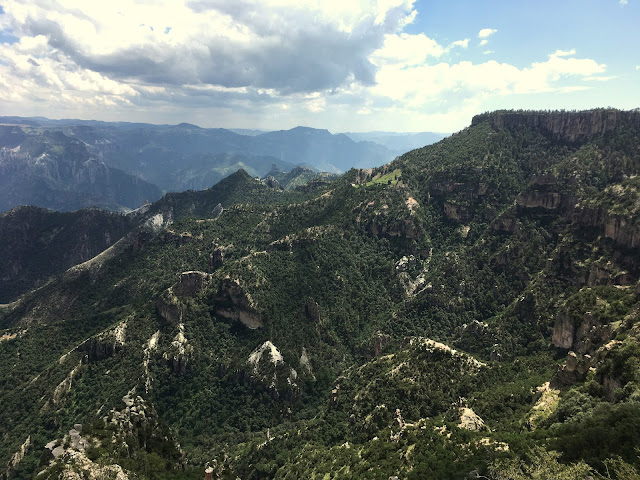 |
View of the canyon from my room balcony; I woke up early the next morning to try to catch the rising sun,
but the far portions of the canyon were still enveloped in mist |
Our room was on the second floor of the portion of the hotel that sat atop cliffs (see below). It had a wood beamed ceiling and a wonderful balcony that DID NOT hang out over the canyon as I had been led to believe, but instead hung over the patio of the first floor room below, which was on the canyon rim. To get to our room, we had to walk a cobbled, up-and-down path before the main building, sometimes at the edge of the canyon sometimes at the edge of a ravine that cut back from the canyon; pass a friendly street dog that dogged our heels until it found another person of interest; hold our breath past a large septic system in the ravine; cross the ravine on an up-angled wooden bridge; and, finally, climb up some wooden stairs.
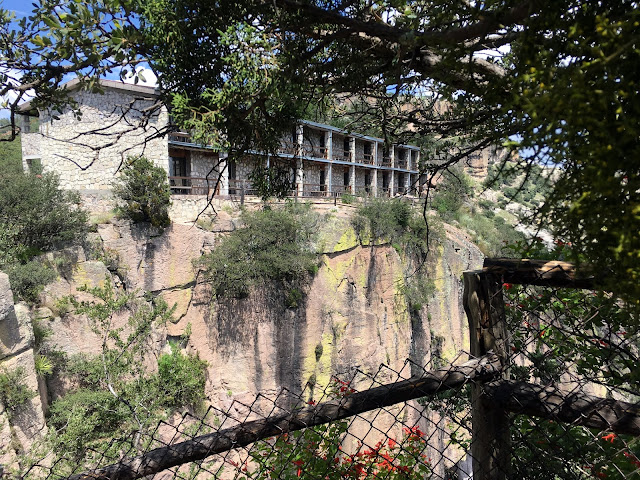 |
Nancy's and my room was the second from left, second floor (the one behind the dark hanging leaves)
and not quite on the canyon rim. |
I was thankful that our porter, a Tarahumara, managed to pile amazing numbers of suitcases on his cart and get each bag to the correct room. Adrian told us that this man, whose name I have forgotten, was 67 and had been working at the hotel for the past quarter century. Adrian urged us to tip him when we left. This I did after he lugged all of our bags to the train station the next day.
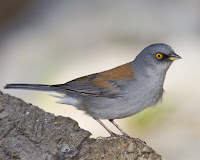 |
| Left: Yellow-eyed Junco |
 |
| Acorn Woodpecker |
On the path to the room Nancy and I saw a Yellow-eyed Junco, a Curve-billed Thrasher, and a Rock Wren. We also saw some Yellow-eyed Juncos later at the train station. While eating lunch, I spotted an Acorn Woodpecker busily trying to drill an acorn into a tall tree and then into the electric pole near it. I took two photos of the acorn woodpecker but neither was very good, so the one at left is from the Internet as is that of the Yellow-eyed Junco.
We ate lunch in the large-windowed hotel dining hall with views into the canyon. Hummingbird feeders were hung outside the big picture windows and I enjoyed seeing very large hummingbirds. I think they were Rivoli's (formerly Magnificent) Hummingbirds at 4.3 to 4.9 inches, but some could have been the slightly larger Blue-throated Hummingbird at 4.5 to 5.5 inches. Both have a distinctive white eye stripe or mustache. I could not be 100% sure of my identification or that of some smaller hummers as they were fast and silhouetted by the sun. The canyon is known to have Violet-crowned, Black-chinned, Costas, Rufous, and Black-throated Hummingbirds as well as the Blue-throated and Rivoli's.
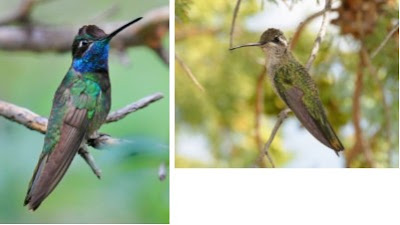 |
Male & female Ravoli's Hummingbirds;
Internet photos, male, David Cree; female, Sam Wilson |
 |
Male & female Blue-throated Hummingbirds;
Internet photo, Nick & Nora Bowers |
 |
Top left clockwise: Rufous Hummingbird, Violet-crowned Hummingbird,
Black-chinned Hummingbird, and Costas Hummingbird; Internet photos |
 |
Here's my cell photo of one of the hummers sitting high in a tree.
You can see how large they are; larger than our kinglets
and some of our gnatcatchers |

Someone, or some group, really needs to create a bird list, bird book, or even a brief bird pamphlet for the area, as well as a booklet showing and describing the area’s flora and fauna. While Adrian had a Nat Geo bird field guide and some poorly translated and vague flower and bird booklets (the flower booklet listed several flowers as "unnamed," and the bird booklet listed the American Redstart as a “Redstar” for example), hotel gift shops need to provide visitors with bird books and bird lists as well as flora and fauna booklets. I saw a squirrel, for instance, and had to memorize its characteristics and then look it up on the Internet to find that it was probably a Rock Squirrel. Also, hotel and area residents could make some money by becoming knowledgeable and conducting flower and bird walks to help turista learn of the area's wildlife.
 |
| There were Tuerkey Vultures enjoying the canyon's thermals but all my cell could capture was black dots, so this is a fine Internet photo that I like of a pair resting on a dead branch |
As it now stands, the biggest attractions at the canyon rim are the Tarahumara artisans with their baskets and crafts, and an Adventure Park where one can ride an aerial tram into the canyon or climb aboard a seated zip line that barrels into the canyon. Of course those of you who know me know that I was first in line for these daredevil aerial rides. Not!
After lunch at the hotel, we walked about a mile along the rim and then caught a tiny zoo type train to the Adventure Park. Here all but Sarene and I trundled off to board the aerial tram into the canyon. Back at the adventure park lodge, Sarene and I drew back and gasped as people took off their shoes and walked out onto a glass floored projection that puts 6,100 feet of chillingly empty space between oneself and the canyon floor--a Mexican version of Arizona’s Hualapai Indian Grand Canyon Skywalk. This was not for either of us height wienies. Then Sarene sat at a table and relaxed on solid ground in the lodge restaurant while I edged out onto a narrow balcony that did indeed hang over the canyon. My back never left the lobby wall, but I managed to take some pix of the tram and also of those who were brave enough to try the zip line. See my pix below.
 |
| Zip line into the canyon |
Where's Waldo? The zipliner (below) is a mere speck only seconds after being released. Since this zip line was continuous and over a mile long, the zipliner sat on a seat and did not manually control the brakes. This caused a problem for Bette Carr of our group. She and husband Ron started out together but Ron soon zipped past Bette, whose zipline eventually came to a full stop hundreds of feet above the canyon floor and some distance from the landing area. A woman climbed out and back hand-over-hand on the cable to rescue Bette. Jonathan shot a video of the rescue. I felt vindicated for being "chicken."
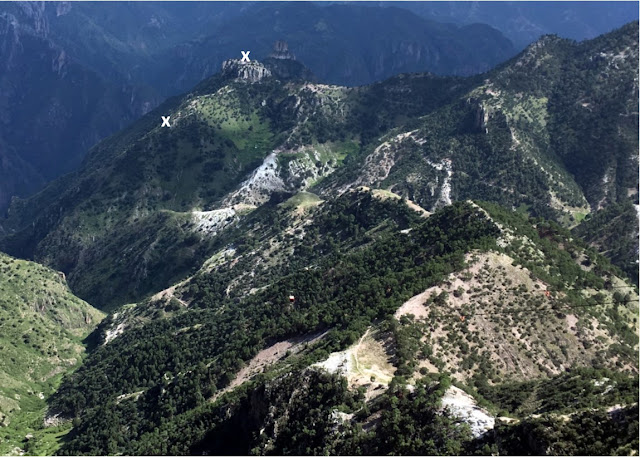 |
| The lower X to the left is the site of the zip line landing. After reaching the landing, the zipliner had to hike and climb 700 or 800 feet on a narrow cliffhanging, knife-edge arête trail to the top of the rock and tram landing (top X) in order to catch a ride back to the lodge in the tram. Jonathan and others who braved the zip line said that the climb was tough and scary in places. |
 |
| The departing aerial tram with those of our group in it |
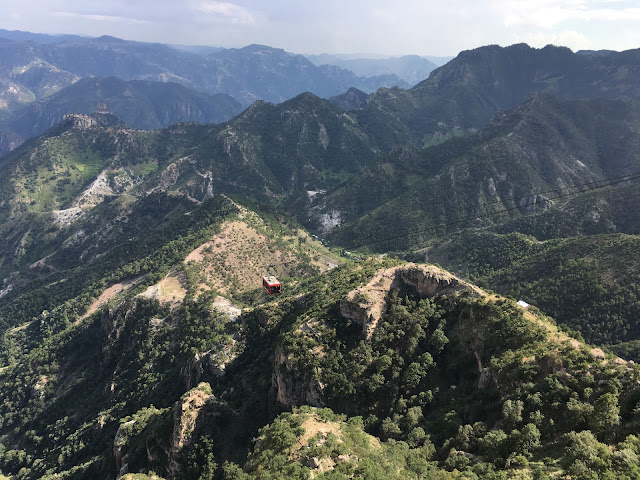 |
| The descending tram; it is headed for the rock plateau near the top lefthand side of the photo. |
 When all had returned on the tram, we were given the choice of walking back to the hotel (about 2 miles) or riding on the little zoo-type train.
When all had returned on the tram, we were given the choice of walking back to the hotel (about 2 miles) or riding on the little zoo-type train. I chose to walk. I took several photos along the way ("Bonsai" tree on a pinnacle of rock, left) and enjoyed myself except when a member of the group posed for a photo at the very edge of the canyon. I have such acrophobia that I cannot bear to even
see someone close to a drop like that. When in view of the lodge, the trail turned to a swinging suspension bridge. Fortunately for me there was a trail around it.
 |
I took this photo because the formation on the side of the canyon looked to me like
a Chinese dragon with its toothy mouth open |
 |
The red roof barely visible in the distance is our hotel.I enjoyed the walk along the rim back to it,
most of it on a path with a rail at the canyon's rim. The curving treeless area top left in this
photo has been cleared for a natural gas pipeline. It is visible in the photo below, also.
I understand that all of the wood cleared was given to the Tarahumara. |
 |
| The suspension bridge near the motel |
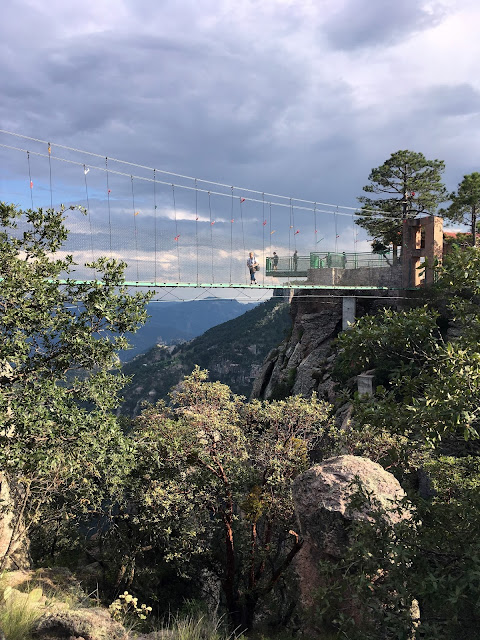 |
| The suspension bridge from the rim trail around it. |
 |
| Firecracker bush or Scarlet bouvardia. Its red flowers called loudly to the hummingbirds in the area. |
 |
| I took this photo on the hike back from the aerial tram because the rocks look like an elephant, but it is in an area above the hotel where some Tarahumara live in caves. We will hike to this area the next day. |
When we got back to the hotel, we met in the reception area and all were served a delicious salt-rimmed margarita before dinner. I remembered getting smashed on this drink back in the 90s, the first time I'd ever had a margarita. Then, it was so tasty that I drank it like lemonade. This time the drink was just as good, but I had the brakes on.
Monday, Sept 11
Copper Canyon and El Feuerte
This morning we had until 11:00 to explore the area at our leisure before a hike to the Tarahumara cave homes in the cliffs above the hotel and a 1:00 departure for el Feuerte on Chepe, the train between Chihuahua City and the Pacific.
 The Rarámuri, or Tarahumara, are an indigenous people living in northwestern Mexico and known for their long-distance running ability. The Spanish named them Tarahumara. Their word for themselves, Rarámuri, means “runners on foot” or “those who run fast.” Because they are a shy people and do not live in large communities, these people developed a tradition of non-stop, long-distance running through their home area of rough canyon country for communication, transportation, and hunting. They run barefoot or in huaraches made of animal skin, or today, made from the rubber of discarded tires. Running is a joy for these people. One Tarahumara ran 400 miles non-stop in a little over 50 hours! Sounds impossible, but it is true. Astonishingly, every individual in the entire tribe
The Rarámuri, or Tarahumara, are an indigenous people living in northwestern Mexico and known for their long-distance running ability. The Spanish named them Tarahumara. Their word for themselves, Rarámuri, means “runners on foot” or “those who run fast.” Because they are a shy people and do not live in large communities, these people developed a tradition of non-stop, long-distance running through their home area of rough canyon country for communication, transportation, and hunting. They run barefoot or in huaraches made of animal skin, or today, made from the rubber of discarded tires. Running is a joy for these people. One Tarahumara ran 400 miles non-stop in a little over 50 hours! Sounds impossible, but it is true. Astonishingly, every individual in the entire tribe—
men, women, old, and young—is capable of running great distances in a single run. Such an extreme feat of endurance has never been seen among humans anywhere else in the world. The Tarahumara also practice persistence hunting of deer and wild turkeys, following them at a steady pace for one or two days until the animal drops from exhaustion.
 |
| Ultra-runner Scott Jurek runs alongside Tarahumara runner Arnulfo Quimare in a race described in Born to Run |
Born to Run by Christopher McDougall is a book about the Tarahumara and their running ability. The book is well written and hard to put down.
 |
| Unattributed Internet photo of joyously running Tarahumara; notice that they are running in their homemade huaraches and that they put their toes down before their heels, a style hat lessens the shock to their knees and hips, unlike our heel-toe running |
 |
Top left clockwise: Traditional huaraches, classy modern huaraches,
Merrell's Barefoot running shoes, and a vendor's regular athletic
shoes and socks; Internet photos. |
 Today, some Tarahumara beg (left), but many more support themselves through the tourist trade,
Today, some Tarahumara beg (left), but many more support themselves through the tourist trade, making and selling artisan grass and pine needle baskets, carved bark animals, jewelry, and woven shawls, among other wares. We were encouraged not to give money to those begging but to respect their dignity by buying their handicrafts. So, after breakfast, I readied my suitcase and put it outside our door for the porter, and then spent most of the morning buying trinkets from and photographing the Tarahumara who had set up their tables in the parking lot beside the hotel and also on the both sides of the covered walkway up to the train station. Most of the male Tarahumaras that I saw wore jeans, tees and ball caps, but the women were dressed more traditionally and wore colorful gathered skirts, kerchiefs, and shawls, but also modern long-sleeved tops, socks, and shoes.
 |
| There is little sexual distinction among the Tarahumara as to tasks. Though I did not see any but women, I read that men, as well as women carry babies in a sling on their backs and share child-raising duties. |
 |
| Both boy and girl babies wear a traditional hat; this is a boy |
 |
| The green baskets are new and have not aged to tan yet |
 |
| Colorful shawls woven by the Tarahumara; these are the kind they use as slings to carry their children. |
While I was shopping that morning, some of our group's daredevils returned to the Adventure Park to try the ZipRider. This longest zip line in the world has a vertical drop of 1476 feet, is 8,350 feet long with a maximum registered speed of 84 mph! The advertising for this zip line states: "All of our visitors are anxious to ride the largest zip line on the planet, located in the largest state of Mexico, in the heart of the one of Mexico´s natural wonders, the Copper Canyon." They must not have included me in their visitor census. I was not anxious to ride the zip line, just anxious.I did like seeing the zip line, though, and hearing the tales of those who braved it. See the caption above about Bette Carr's rescue. Her zip line ride came to an abrupt halt, leaving her dangling hundreds of feet above the canyon floor. I think the vultures would have come for me as I would have turned to dead meat on the spot.
 |
| Internet advertising photo |
Linda Green & Joanne Cash, sisters on the tour, eagerly tried all the daredevil stuff the tour offered: hunting down the dunes rattlesnake, braving the ZipRider, riding the aerial tram, casually walking across the glass floor and taking photos of their feet and the chasm below them, prancing across the suspension bridge, sampling tequilla with rattlesnake in it, etc. I would have liked to have been as daring. I felt like a wuss by comparison.
When the zip line daredevils returned—
all looking older than when they had left—
Adrian led us on a hike up through the pines and rocks to the Tarahumara caves above our hotel.
 |
A couple at the bottom of the trail before the cliffside cave homes; I do not know whether they lived
in one of the caves or not, but they had set up a table containing their crafts at this intersection.
The woman is making a pine needle basket, a pastime for them as easy as knitting is for us.
Some of the pines in this area have exceedingly long needles as you can see. |
 |
| Entrance to one of the cliffside cave homes |
 |
| An elevated chicken coop to deter predators |
 |
| Jeans, shirts, and socks--modern day Tarahumara attire--drying before a cave home |
 |
| The hotel shot from the path before the caves |
This hike was announced as a bird walk, also. I saw White-throated and Black Swifts, and about 15 feet off the trail just after the second cave home, I spotted a bat hanging from a low bush. Several borrowed my binoculars and took turns viewing the bat . . . only to realize after a bit that it was
not a bat but the breast and closed wings of a Blue-throated Hummingbird. The hummingbird's head was behind leaves, but when the bird eventually moved, Adrian spotted its blue throat and we could see that it was a hummingbird. Why it remained perched immobile for so long and twice returned to the same perch is a mystery.
At 1:00, we gathered at the train station to board El Chepe, the daily train that runs between Chihuahua City and Los Mochis on the Sea of Cortez 406 miles to the east, crossing the heart of the Copper Canyon along the way. This scenic railroad was started in 1881 and finally finished in 1961. We were on our way to el Fuerte (The Fort), a colonial town 50 miles or so from the end of the line and the Sea of Cortez in the Mexican state of Sinaloa
. The train station was crowded with luggage, food stalls wafting mouth watering smells (we were to have late lunch on the train), people waiting for the train, and the Tarahumara selling their wares. I took my absolute favorite photo of the trip here: a Tarahumara baby with her mother who was setting out her wares (see cover photo and below).
 |
| El Chepe entering the Divisadero Train station; Internet photo |
 |
A Tarahumara mother unpacking her wares at the Divisadero Railway station;
her darling baby became my favorite photo of the trip |
 |
| Favorite photo of the trip; only time when I wished I'd lugged my large camera along |
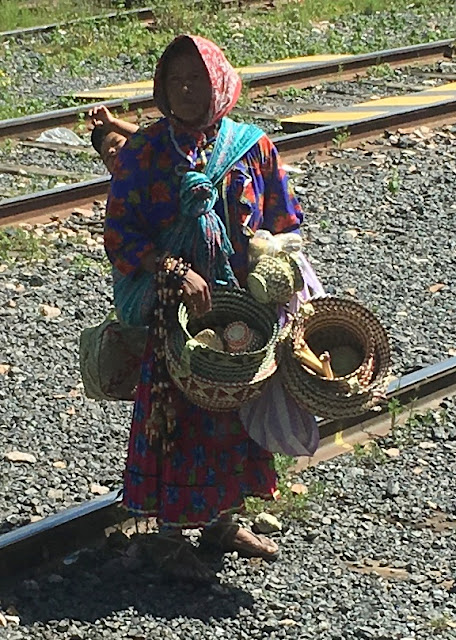 |
This Tarahumara mother on the tracks near the departing train is carrying at least
a one-year old on her back; the child is old enough to help by carrying the bag
hanging to the woman's right and to wave to prospective basket buyers |
 |
Both of these Tarahumara women selling baskets to tourists on the train are carrying
older heavy kids but have straight backs and moved with ease along the train tracks;
note that they are wearing the traditional huaraches, too |
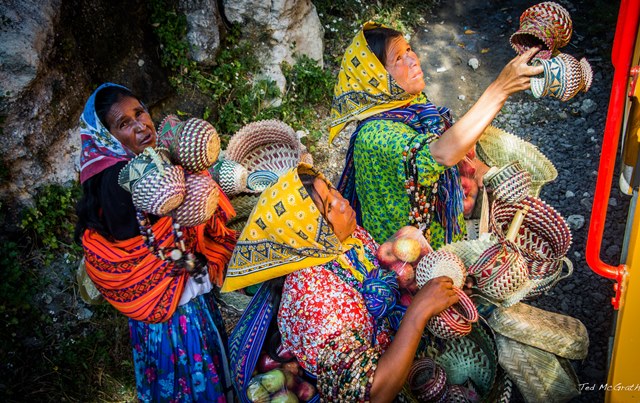 |
| Colorful Internet photo of women pedaling their wares at the train |
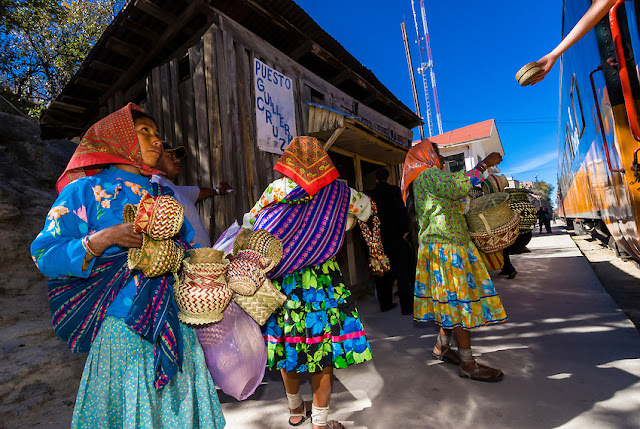 |
| Another Internet photo of Tarahumara women selling to tourists on El Chepe |
El Chepe suggests Butch Cassidy and the Sundance Kid, but guards (Federales) armed with big guns rode along to discourage budding modern day bandits. The guards seemed bored and spent most of the trip in the back of our car or in the dining car, so we adopted their sang froid and none of us feared an imminent stick-up. We were told not to take photos of these guards, however. We were assigned seats before we boarded. Our group took up about half a car, but we were free to roam the cars, as well as to hang out in the jostling, noisy space between cars. This is where those of us who wanted to photograph the countryside sans window glass went. Nothing blocked our view but a waist-high door that sometimes unnervingly swung open. Also, no signs deterred anyone from sticking head or hand holding a camera from this opening between cars. If a passenger had done so, he or she was bound to lose said head or hand to the tree branches, cut bank rocks, or tunnel openings that often came within inches of the train.
This was a long--6+-hour train ride, so I contented myself by looking at the passing scenery: pine forest, pine forest, pine forest, pine forest, rock outcropping, tunnel, rock outcropping, tunnel, tunnel, tunnel, pine forest with some oak, madrone, alder, juniper and poplar, etc. At one point we got to a spot on the line where the railroad actually looped around and descended three switchback levels (red loop on map below). At the top we could look down on the bridge we were to cross and see a tall waterfall. The train crossed the longest bridge and the highest bridge and ducked into 86 tunnels. One of these tunnels was over a mile long and actually had an U-curve in it. See the map below. It's a poor map because it is a photo of the map in the train car and the tunnels are pale grey. The u-curve tunnel is just above the dot at Témoris. Photos below taken through the train window.
 |
| Internet photo, obviously |
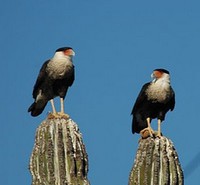 |
| Crested Caracara on cactus |
 As we descended from the top of the Sierra Madre into the canyon, the pine forests gave way to oaks, cottonwoods, madrone, and balsa trees with manzanita bushes, saguaro, cholla, and ocotillo cactus mixed in.
As we descended from the top of the Sierra Madre into the canyon, the pine forests gave way to oaks, cottonwoods, madrone, and balsa trees with manzanita bushes, saguaro, cholla, and ocotillo cactus mixed in. The cacti, particularly the organ pipe cacti, grew among the deciduous trees. I had never seen such a surprising mix. The sheer rock faces of the canyon became rolling hills and tropical farmlands. Palm, banana, papaya, and mango trees began to dot the landscape. Often Crested Caracaras, the bird depicted on the National Emblem of Mexico, and Black Vultures, their wings outstretched to catch the sun, perched atop organ pipe cacti; and quite a few saguaro cacti sported nest holes drilled by Gila Woodpeckers (above).
 Copper Canyon is a group of six canyons formed by six rivers that later merge to form the Rio Fuerte that drains into the Sea of Cortez.
Copper Canyon is a group of six canyons formed by six rivers that later merge to form the Rio Fuerte that drains into the Sea of Cortez. At the bottom of the canyon we followed one of these rivers that I think Adrian said was the San Pedro River, sometimes at near river level and other times high above it. At one point I saw a flock of 15 or so mid-sized black birds with white wing patches flying above the river below. I believe that these were Phainopeplas.
We enjoyed a late lunch on the train. I ate with Sarene, Joan, and Nancy. I mention this because all of these women were petite, and the dining car booths placed the tabletop nearly under their chins. The table was even high for me and I am tall. I wondered about this in this country of Lilliputians. Nonetheless, it was good to get out of our seats and to be seated facing each other in the dining car.
Eventually we arrived in el Fuerte. El Fuerte is a colonial city, what Mexicans call a "Magic Town" because the old buildings have been restored and refurbished and tourism fills the city's coffers. The Magic Towns Program was started by the Mexican Government to help preserve cities that best embodied Mexican culture, history and tradition. Launched in 2001, the program provides financial aid to places such as el Fuerte that "reflect the beauty of traditional Mexican culture." The city sits on the now wide but shallow el Fuerte River, which we will float, bird, and botanize tomorrow morning.
 Our Hotel La Choza was modest looking from the outside but wonderful when one entered its courtyard.
Our Hotel La Choza was modest looking from the outside but wonderful when one entered its courtyard. As far as I could determine with my limited Spanish, this hotel's name means "The Hut" or "Shack." It was anything but and would be our home for the next two nights. Nancy's and my room was on the second floor, had a beamed ceiling and a crucifixion on the wall. We cranked up the AC as the outdoor temps in this tropical city were in the low 100s with high humidity, quite a change from the cool breezy canyon rim..
 |
| The sign outside Hotel La Choza points to the the 17th century cathedral, the area's archaeological digs with their petroglyphs, and the river. The bottom of the sign reads "el Fuerte, a Magic City." Notice the Independence Day red white and green decorations. |
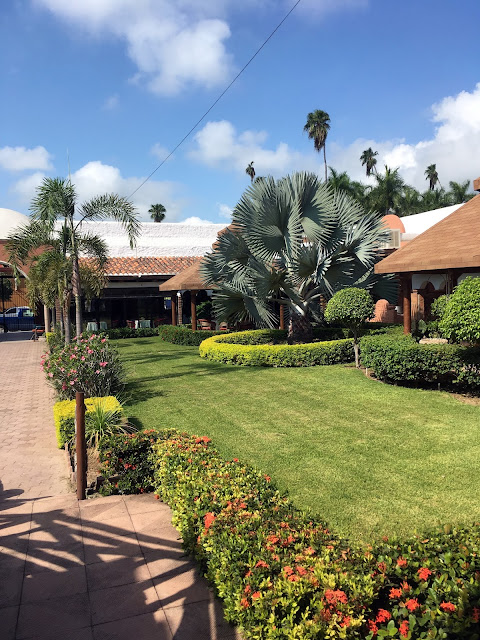 |
| The beautiful courtyard at La Choza, it and the dining room/patio its best features |
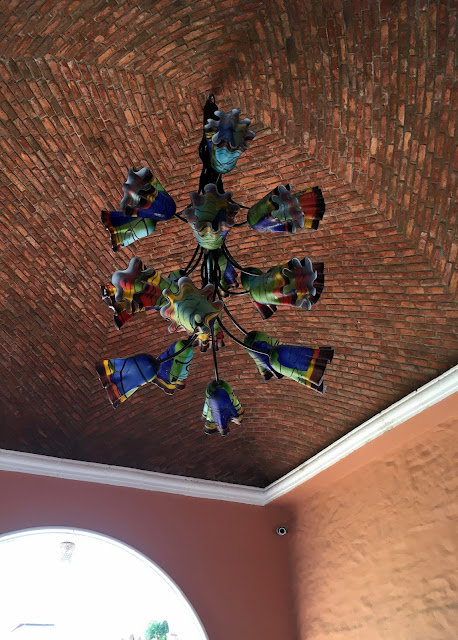 |
| The chandelier in the La Choza entryway; note the domed brick ceiling |
 |
| Internet view of the La Choza courtyard obviously taken earlier because of the size of the palm and the plantings.. |
That evening we enjoyed a wonderful black bass meal in the hotel dining room, the bass fresh from the nearby Fuerte River. On my way to the dining room, I discovered a sad caged parrot on the walkway behind the pavilion. This mid-sized parrot was in a smallish empty cage with no water or food. Two of its beautiful primary feathers lay on the floor of the cage. It sat on a corner of its perch and would not look directly at me the way a mentally healthy curious parrot would. Later when I looked, someone had placed a coffee cup of water and a tortilla in the cage. I felt so bad for this bird that when I awoke with insomnia at 2:00 am, I briefly contemplated sneaking down and releasing it. Of course I did not follow through on this crazy thought. Releasing the bird may have been crueler than leaving it in solitary confinement in the cage. I did not know whether this parrot could fly, whether it could find others of its species in the area, or find food for itself. I really hate to see caged birds and mammals.
Tuesday, September 12
El Fuerte, Sinaloa, Mexico
El Fuerte has three large dams nearby, Hidalgo, Huires and Dominguez, which make the Fuerte River broad but shallow. We began the day with a float trip down this river on which the town sits. We were in three rafts, my raft rowed by a 10 or 11-year old boy and containing our naturalist/medicinal herbalist. A bit before the takeout, an animal sanctuary sat on one side of the river. Large parks and picnic areas dotted the city side.
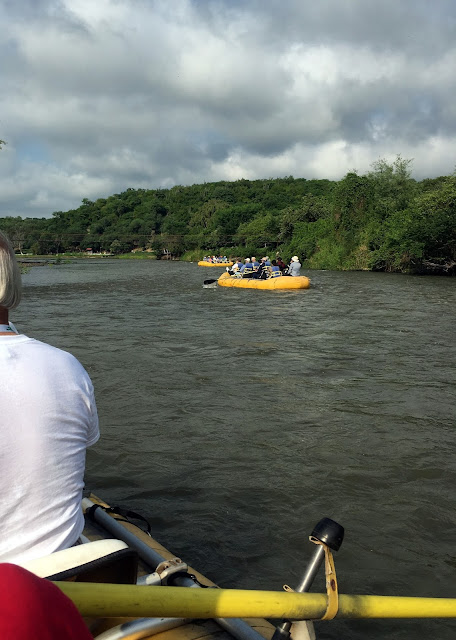 |
| Skimming along the little riffles |
 |
| Oops! Cattle crossing the shallow river. This was only half of them. There were quite a few on the left side of the river also. |
Not long after we entered the river, we tied up and walked a trail planted with medicinal herbs, which our naturalist and herbal medicine expert explained to each of us. The trail was easy walking and was bordered by beautiful purple morning glories and various deciduous trees and cacti.
 |
| A very large grasshopper, maybe 2.5 inches long |
 |
Beautiful purple morning glories. By the time we returned to the river,
most of them had closed for the day |
 |
| Gila woodpecker nest holes in a trailside organ pipe cactus |
 |
I am not sure of the name of this crazy looking plant. When I later asked Adrian what the name of the spiky fruit was, he thought it was Guasima, but there were several other spiky plants. If this is guasima herb, it produces these strange fruits that are edible. It is covered in rough barbs and has a strong scent of honey. This herb was used as a cure for asthma, uterine pain, and hemorrhages by the Mixe Indians. The Huastec Mayans, on the other hand, used it’s fresh bark boiled in water to cure dysentery, wounds, gastrointestinal pain, and fevers
|
At the end of the herb trail we came upon an archaeological dig, The site contained 45 stones etched with more than 100 engravings.
Actually I do not know if true archaeologists had much to do with this site. It was privately owned on a farmer's piece of land. The farmer came and joined the group. Angelo explained each petroglyph to us. I was a little alarmed that these irreplaceable petroglyphs were unprotected from the elements and that the farmer had dug around some of the stones, unearthing them but also gouging some of them with his shovel. The most interesting one, to me at least, was one that showed a human stick figure with great coils above it. Angelo said that this was a figure of a pregnant woman giving birth, the coils adding up to nine months. There was also a fox, a caterpillar, several suns, and several other human figures as well as patterns and symbols that were not interpreted.
 |
| The site of the petroglyphs; note the organ pipe cactus growing among the deciduous trees and shrubs |
 |
| Cat face at bottom right and vertical caterpillar left |
 |
| Two suns to left and in the V crack a stick person |

After the archaeological dig and the medicinal plant walk, we continued our river float, seeing great blue herons, osprey, vultures, great-tailed grackles, a grey hawk, a tiger heron in a riverside tree, and many great egrets and social flycatchers, as well as mallards, green herons, tree swallows, a gaggle of semi-domestic geese, neotropical cormorants and several unidentified species of hummingbirds.
Because of the area’s co-joined ecosystems: the start of the Sierra Madre, the end of the Sonora’s Desert, and a location an hour from the coast, Rio El Fuerte has a reputation as being a birding hotspot. We were told that more than 60 species of birds were frequently spotted from the raft, as well as interesting and exotic flora such as Senna, Coral Bean, Kapok, Amapa, Palo Verde, Ironwood, Cypress, Strangler Fig, Jumping Cholla cacti, and more.
Jumping cholla cacti have developed several adaptations to survive in the arid desert environment. Its thick covering of spines shades it from the desert heat. Its spines also prevent animals from eating it. The jumping cholla’s stems are separated into segments that store water and allow for photosynthesis. They separate easily so that animals and even a strong wind can cause them to “jump” away from the parent cholla to disperse their seeds. These cacti also grow in the Mojave Desert of California near San Bernardino where we lived in the 70s. When he got too close to one, my husband found out the hard way that they do indeed “jump.’ A piece of cholla attached itself to his bare thigh. How were we to remove the piece of cactus without getting punctured by its spines? There was not a soul around but my husband and our two young daughters, so I took off the halter top I was wearing and used it to grasp the cactus and remove it from my husband’s leg. You’d better believe that I inspected the top thoroughly before putting it back on.
When we returned from our raft float, several of us walked back to the La Choza with Adrian. Then all quickly cleaned up and were led on a brief walking tour near and around the palm tree shaded square across from La Choza. First we stopped at an indoor farmer's market, where we were shown all of the local produce, cheeses, and meats, including dried rattlesnake meat and powdered rattlesnake. Rattlesnake meat preparations and powdered rattlesnake capsules are believed to be beneficial to the treatment of cancer.
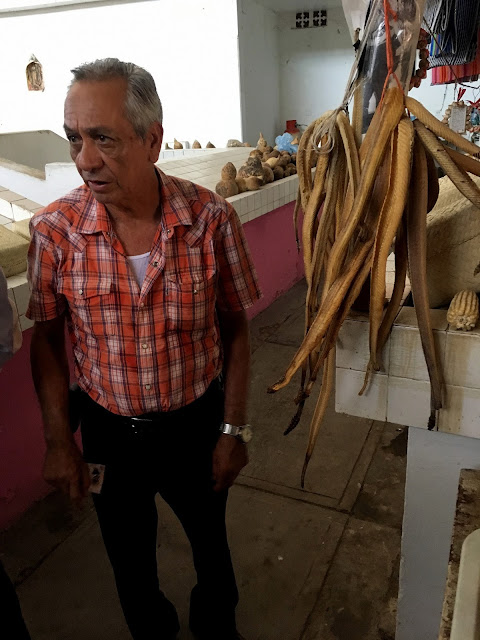 |
| Vendor next to dried rattlesnakes |
We were also taken to the Government Palace where we were entertained by a troupe of student dancers. Unfortunately their sound system broke in the middle of their second dance. Probably it and the giant fans and air conditioning overloaded the circuits. Nonetheless, the dancers recovered nicely singing through the remainder of their second dance and then dancing to their tunes broadcast from one of the dancer's cell phones. All of the photos below are of the same troupe of six dancers who quickly changed their costumes between sets. My cell takes so-so pix inside, so those below are the best I could do.
 |
| Cpourtyard of El Fuerte's Government Palace; Internet photo |
 |
These women are dancing while balancing a glass of water on their heads. One lost the glass
of water and it broke, leaving dangerous spikes of glass in the middle of the dance floor,
but these dancers continued their routine unperturbed. |
 |
| At the end of the performance, some of the tour members danced and posed with the troupe. |
After this performance we visited the 17th century Sagrado Corazon de Jesus or Church of the Sacred Heart of Jesus. By this time, the heat at 102F was getting to me, but fortunately there were welcome fans at the sides of each row of pews. I listened to Adrian's explanation but was somewhat distracted by a politician I could see exhorting a crowd on one side of the plaza.
Nowhere is the exuberance and happiness of the upbeat Mexican people expressed more openly than in the bright colors of their dress and the colors they paint their houses and buildings. Below is a photo collage of el Fuerte and other Mexican houses, some photos mine and some from the Internet.
 |
The house at the bottom left has a jerky drying cage on its roof. Adrian talked to the owner who said
that he bought the meat and dried it for sale. The area was screened to prevent insects and and animals
from sampling the jerky. |
As we were on our own for lunch this day, several of us left the church and walked directly to a small restaurant that Adrian had pointed out on the walking tour. It was across the square from the church and behind kiddie carnival rides that had been set up around the square in anticipation of September 16, Independence Day. I cannot now remember what I had for lunch but I can say that I enjoyed wonderful food over the week that I was in the country. The tortillas served at nearly every meal tasted nothing like the store bought tortillas we are used to. They were light and delicious.
That evening before another great meal in La Choza's dining room, we were entertained by a group of Mayo Indians performing Danza del Venado, the dance of the deer. The Mayo or Yoreme are an indigenous group living in the states of Southern Sonora, Northern Sinaloa and small settlements in Durango. Originally these Mayo people lived near the Fuerte and Mayo River valleys.
Adrian knew the family and had asked them to come to the hotel courtyard for the performance.The deer dance of the Mayo people is sacred and passed down in the family. The deer represents good, and the dance is said to have been held before a deer hunt, thanking the deer for its sacrifice so that the people may live. Deer dancers, pahkolam, “old men of the fiesta” wear rattles around their ankles made from butterfly cocoons filled with tiny stones. The cocoon rattles honor the insect world and are also said to look like corn. The dancer wears a belt from which hang deer hoof rattles honoring the many deer who have died.
cl |
I was near tears toward the end of the dance when the deer was killed
and lay dying, its water drum heartbeat getting slower and fainter until it abruptly ended |
Wednesday, September 13
Chepe train from El Fuerte to Creel
After the deer dance and after dinner, we returned to our rooms to pack up our things and get ready for the next day's 8-hour train ride back up through the Copper Canyon to Creel. Since we would be traveling the same route we'd arrived on, I devised a Scavenger Hunt to help us view the scenery and pass the time. The plan was for each person or team who wanted to conduct the hunt to pitch in a dollar. The person who spotted all of the items first would win the pot. I had the front desk make 25 copies . . . of which I needed only 5! so we forgot the pot and played for fun. The rest of the gang had already seen it all, so were content to read, sleep, play with their phones, listen to music on their headphones, or talk to their seatmates. That is, they were content until those five playing got into it. Then others tried to help by calling out items and urging the players on. It turned out that the most difficult items to see (and all had to be seen
outside the train) were the b/w dog, even though there were many street dogs; the horse & rider, and the black cow. Like the b/w dog, there were many cows, but few black ones. Linda tried to turn a goat into a cow, but was called out. Players eventually saw all three of these items, but only the horse & rider from the train. No one had seen all 31 before we reached Creel. Below is my list of scavenger sights, misaligned but much neater than the original handwritten list:
Adrian loaned me a booklet put out by another touring company he guided for. I know he helped put together a tour company booklet, and it may have been this one because it seemed to reflect his sense of humor. In it were "The Traveler's Ten Commandments." I was sharing them with my seatmate and when we began laughing, Adrian insisted that I stand up and read the commandments to the other members of the tour. It was difficult to read because of laughter.
When we got back to Divisadero, we could leave the train for 15 minutes. Many of the group took advantage of this stop to buy last minute crafts from the Tarahumara. It was early evening when we pulled into the train station at Creel (below), ending the train portion of our tour. We were transported to our hotel in an old school bus.
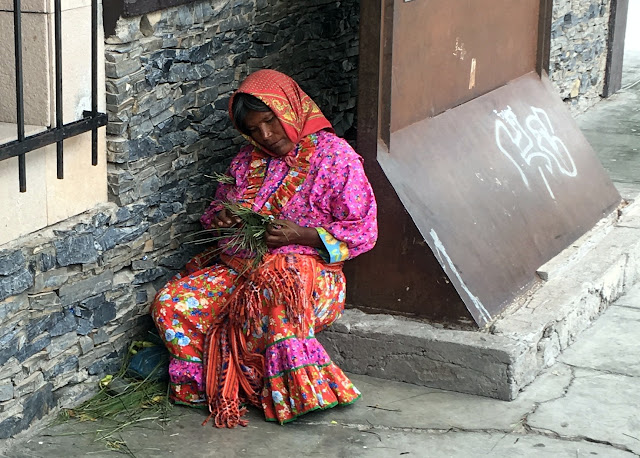 |
| Tarahumara woman weaving a basket at the Creel train station |
Each day before we arrived at our stop for the night, Adrian would read off our room numbers and we'd find our room key in the door to our room. Adrian had a great sense of humor and a couple of times he called out the room numbers and, when finished said as if to himself, "Adrian . . . the presidential suite" smile. Well, in Creel we all got the presidential suite. Our rooms at Quinta Mission Hotel
were enormous and this hotel was unique. Built from adobe in the colonial style, the 20-room all-suite hotel was powered by wind turbines and solar panels and featured beamed ceilings kitchenettes, and heated floors. No AC. It is not needed at this elevation and we left our screened window and patio door open for the breezes. Also, the hotel was only a short walk to the town center. We had eaten breakfast at La Choza, lunch on the train, and were on our own for dinner, so the town center was convenient.
At the hotel, we also met Eloi, our bus driver, again. He bused those who didn't want to walk the short distance into town. I ate dinner with Linda, Joanne, Sarene, and Joan.Then we walked back to the hotel, some doing more souvenir shopping on the way.
 |
Nancy in our large room. I am taking the photo from the patio end of the room; all along the left side of the room
was a chest of drawers, TV, kitchenette, computer table, and closets.The bath was also large with glass shower doors. |
Thursday September 14
Creel to Casas Grande
I am struggling with this blog now. I have been home a little over a week and a lot has been going on since my return, thus I've had to snatch moments to work on the blog and my memory of the last two days of the tour and even the order of our stops has suffered. I took notes on my cell and also on the backs of napkins, paper towels, and any other scrap of paper I could find, but often my notes are one word or choppy or I cannot read my scrawl. So. . . bear with me.
This morning we ate a buffet breakfast at the hotel. I wanted a bowl of raisin bran for breakfast but could not tolerate the lactose laden milk, so settled for scrambled eggs and toast. On my next adventure, I plan to bring a quart of almond milk and a bag of hard candy mints. I craved cereal in the morning and a mint following each of our Mexican meals.
 From the bus today we saw many parents walking their children to school as well as street dogs and smog over the cities we drove through. The fencing in one town was creative-- a gate made of bicycles and a fence made of stacked rocks in a wire frame. Each village we pass through has "sleeping policemen" and signs warning of these speed bumps. The sign looks something like a bra (see the top image in the picture left). Before one village some pranksters had added nipples to the humps, turning the "bra" into breasts. Elois navigated these speed humps carefully in the big bus.
From the bus today we saw many parents walking their children to school as well as street dogs and smog over the cities we drove through. The fencing in one town was creative-- a gate made of bicycles and a fence made of stacked rocks in a wire frame. Each village we pass through has "sleeping policemen" and signs warning of these speed bumps. The sign looks something like a bra (see the top image in the picture left). Before one village some pranksters had added nipples to the humps, turning the "bra" into breasts. Elois navigated these speed humps carefully in the big bus.

We made a banõ stop at a convenience store at one point. Across the road were the usual tourist trinket peddlers as well as a guy selling bicycles and cookers made of plow discs. We had stopped at this convenience store on the way to Chihuahua also and each time sampled its avocado ice cream bars. Tasty very delicate flavor. We were in apple country so on the way down I bought a small bag of dried apples to eat on the bus. Trouble was, they were not dried enough and were like chewing tasteless rubber. I passed them among the others and most of the bag disappeared. When no one asked for seconds, I threw the rest away when we got to the hotel. One of the most prevalent convenience stores is OXXO--"hugs and kisses" as Adrian calls it.
Our first stop today-- excluding banõ stops--was at the cave home of an old Tarahumara woman. Today Tarahumaras live in many different ways. There are only a few who live in caves still. Most live in adobe huts covered with a tin metal roof that was given to them from the government. But this woman had lived in her cave house since a child and had even borne children of her own in the cave. I'll let the photos below tell the story.
 |
The path up to Doña Juana's house with the soot blackened outer wall--actually, Doña Juana
was not the woman's name. Older women are respectfully addressed as Doña, but I cannot
now remember the woman's given name |
 |
| A balanced rock near the cave home |
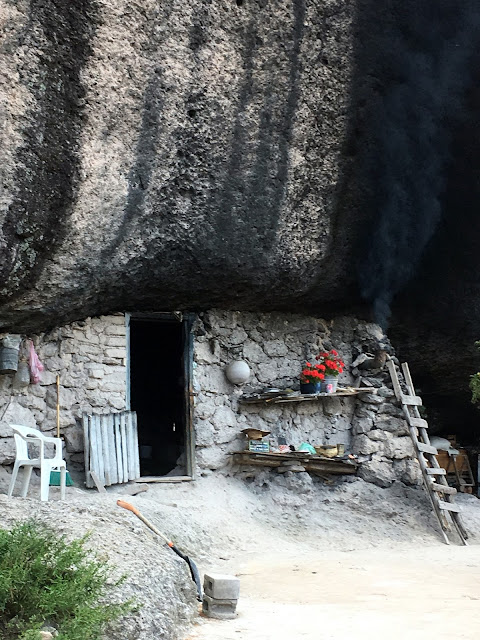 |
The entrance to the home, brightened with red flowers. We toured inside which contained one
very large king-sized bed nearly in the center of the room, four smaller beds along the walls,
and a woodburning stove (the soot culprit) that vented as shown in the photo below. Hanging
from the ceiling was a small crucifix. |
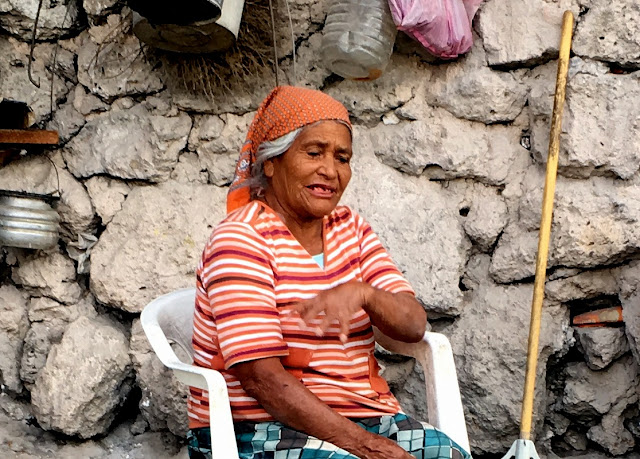 |
| Doña "Juana," the home owner, was born in the cave and gave birth to four children who no longer live in the cave--one sister lives a bit farther down the cliffs in a detached regular house that was built for Doña "Juana" but which DJ never took to. I am not sure how many live in the cave house with her now |
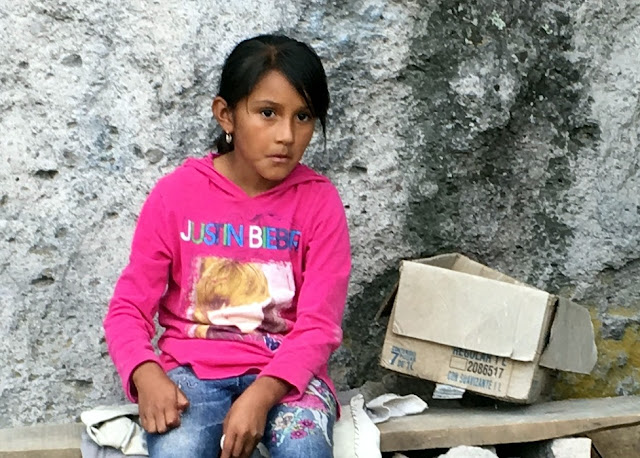 |
| Doña "Juana's" niece, dressed in a modern Justin Bieber hoodie and embroidered jeans |
 |
| Doña "Juana" and Adrian outside her home. Her dogs all looked to be descendants of chihuahuas. Adrian explained to us that chihuahua dogs were not, as many think, native to Mexico but were brought to Mexico from the Phillipines. |
 |
Doña "Juana" and some of her dogs. In this photo you can see the improvised rock bench with its
plank top that her niece was sitting on; the blue in the background was a painting of a pine girdled lake with some wolves or coyotes painted by a relative. One of the coyotes/wolves had what appeared to be a fish in its mouth. |
 |
| Doña "Juana's" storage area and wood pile. Note the branches of the artificial Christmas tree stored left. |
 Our next stop was at Lake Arareko at the top of the Sierra Madre Occidental only about 5 kilometers from Creel.
Our next stop was at Lake Arareko at the top of the Sierra Madre Occidental only about 5 kilometers from Creel. We were told that because of its beautiful landscape; its surrounding conifer, oak, and madrone forests; and its interesting rock formations, Arareko was a well-known tourist destination. We did not need to be told this. Its facilities are run by the Tarahumara, and they were waiting for us turista with tables of their artisan crafts set up at lakeside. I was beginning to see that many of our stops had been arranged primarily to financially help the indigenous Mayo, Tarahumara, and other Mexican people we were introduced to or who entertained us. A busload of Americans with money to burn? Come our way, please. I did not mind. These people needed the infusion of tourist money. I bought several trinkets at the lake to take home to friends.
We stopped in Bocoyna and toured its ancient mission and then walked to a nearby boarding school.
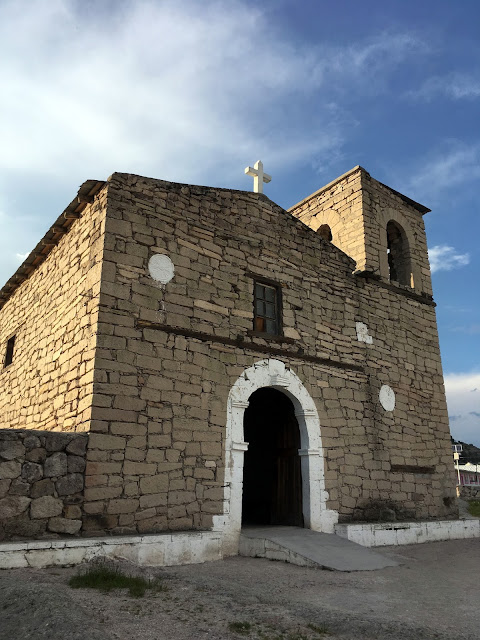 |
Bocoyna mission, built by the Jesuits in 1692.
|
The school had 10 new flat screen computers. I think, but I am not sure, that the Tewecado Trust, Inc., a US-based not-for-profit organization operated by volunteers provided these. The children had just finished lunch. Several young girls dressed in traditional Tarahumara colorful skirts were sweeping up the cafeteria. We were taken to the girls dormitory where we saw the lockers, washroom, and tidy blanketed bunk beds of the girls who boarded there. One of the blankets was black and white and had an American football motif.
 |
This boarding school was a short walk from the mission with about 150 day students and 70 Tarahumara boarding students. Tarahumara and Mestizo children who live at and/or attend the school may board for a week, a month, several months, or even a year. Some walked for over three hours to get to the school.
|
 |
| The girls dormitory |
After our tour of the school, Eloi drove us to an interesting area nearby so that we could see frogs and mushrooms. What the? When we arrived we understood. The area was strewn with boulders that looked like frogs and mushrooms.
 |
| Frog rocks |
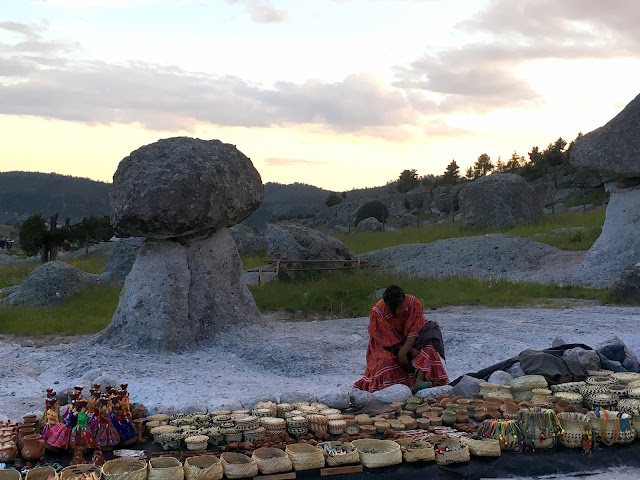 |
| Mushroom rocks with vendor's crafts. At this point it was getting dark, so this was our last stop for the day |
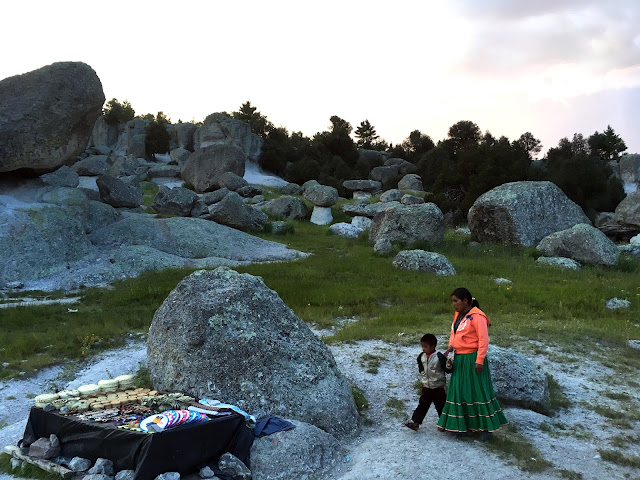 |
| Always the tables of artisan crafts at every tourist stop. The frog and mushroom rocks were no exception |
On the seventh day of the tour, we were treated to a light lunch of homemade sausage, cheese, rolls, butter, and lemonade or iced tea at a Mennonite farm. The fare was delicious. We snooped in their pantry and looked at the sale clothing hung at the side of the room: caps, long dresses, etc. One could buy cookies and other baked goods here, too. This particular family also made and recovered furniture for sale. The side yard was full of overstuffed chairs and recliners. They had a pen of chickens. Mixed in with the chickens were doves, which the family also raised for food. They owned extensive farmland and a pretty and well-fed Appaloosa
horse. This family was very cheerful and pleasant, their children startlingly blue-eyed and blond haired "Campbell's Soup models" as Adrian called them--standouts in the midst of so many black haired and dark-eyed children. On the way out, we passed the Mormon School that Adrian had attended.
 |
| These delicious homemade rolls were served with freshly churned butter and rhubarb and peach jams |
After our Mennonite lunch we drove for a couple of hours though Mennonite country, the roadsides looking for all the world like we had entered the U.S. Many signs were in English and we passed farm machinery stores, John Deere dealerships, pecan and apple groves, vast cornfields, and even rolling field irrigation systems.
Our next stop was the Centro Cultural Paquime Museum and archaeological site in Casas Grandes. Since I had been to Mesa Verde only two months prior to the trip, I could instantly see similarities--multiple roomed structures, T-shaped doors, domesticated turkeys, multi-story adobe structures. One aspect of this culture that fascinated me was their ability in the Chihuahuan desert, far from the birds’ tropical range,
to somehow breed and raise Scarlet Macaws, birds used in Mesoamerican ritual. We even poked into the room where the Macaws were kept. It contained small adobe huts along each wall.
Read about this fascinating site on the Internet: https://www.desertusa.com/desert-people/paquime.html
 It was heating up and there was no tree cover at the site, so I opened the umbrella that Mayflower Tours had sent me. This was the only time I used it on the tour as the rainy season had occurred prior to our arrival and all stops but El Fuerte were in cool breezy areas. Before taking the trail to the digs and restoration we walked in the museum's desert garden where we saw the usual ocotillo, cholla, agave, and yucca. On one of the agave plants was a very large black-and-yellow grasshopper(see below).
It was heating up and there was no tree cover at the site, so I opened the umbrella that Mayflower Tours had sent me. This was the only time I used it on the tour as the rainy season had occurred prior to our arrival and all stops but El Fuerte were in cool breezy areas. Before taking the trail to the digs and restoration we walked in the museum's desert garden where we saw the usual ocotillo, cholla, agave, and yucca. On one of the agave plants was a very large black-and-yellow grasshopper(see below).
 |
| I think that this is a nearly mature Southwestern Lubber Grasshopper (Romalea microptera) or a Horse Lubber AKA Mexican General (Faenipida eques) |
 |
| An Internet photo but I include it to show how close we were to the Sierra Madre Occidental, part of mountain ranges (cordillera) that consists of an almost continuous sequence of mountain ranges that form the western "backbone" of North America, Central America, South America, and Antarctica. |
 After walking the ruins, we welcomed the air-conditioned museum building.
After walking the ruins, we welcomed the air-conditioned museum building. In the museum gift shop I bought a piece of Mata Ortiz Pottery as the gift shop was organized to take a credit card and I had little spending money left. I think I arrived home with $7 in my wallet. The piece is beautiful as you can see in the photo left. It has a little plug in the top. When I bought it, a salesperson hustled it to a table for wrapping. It was wrapped in yards of bubble wrap and placed in a square priority mail box.I had no trouble getting it through customs the following day. Care instructions include placing a plastic bag of dry sand in its bottom to help stabilize it on a display shelf. Instructions also warned against filling with water or using for food consumption. I will use my pot simply as eye candy. It is hard to think that all of that design is meticulously hand painted without a wheel and with a tiny human-hair brush, too!
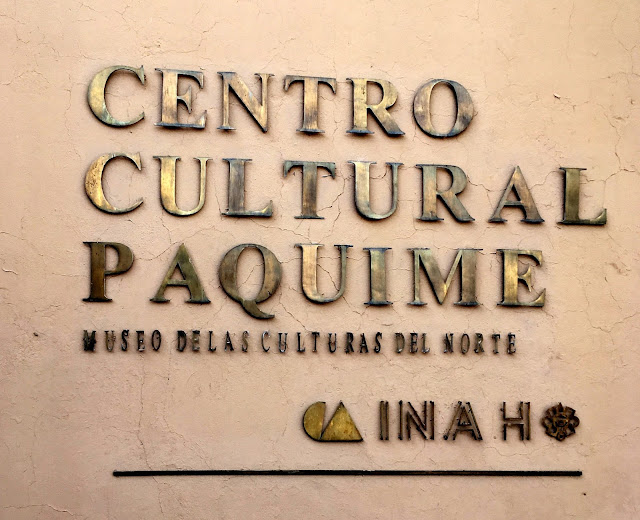
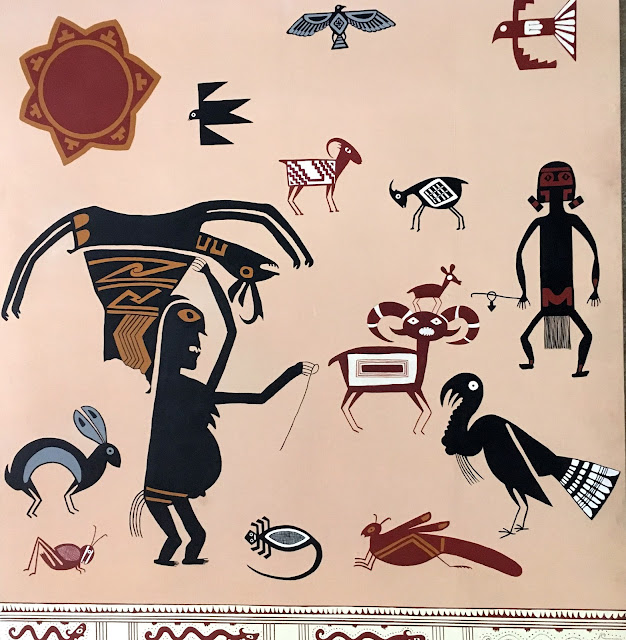 |
| Interesting that there is what appears to be a cricket and a large grasshopper like the one I photographed in the gardens |
It was getting late but we all eagerly anticipated our next stop: A Mata Ortez Pottery demonstration. Now we would get to see how the pot I bought at the Museum gift shop was made. Mata Ortiz pottery, also known as Casas Grandes pottery, is one of the finest ceramics in the world. Led by Juan Quezada, the entire pueblo of Mata Ortiz creates and paints stunning pottery by hand--no pottery wheel. We were in for a special treat as we were going to see a demonstration by a potter that Adrian had gone to school with. Her name was
Silvia Eldemira. Her work was well-known as was she. Recently Silvia had recently taken her pots to a stateside teaching seminar.
When we arrived, she had a shaped, painted vessel ready to fire, so we got to see the end process first. Silvia built a circle of sycamore logs, placed the vessel in the center under an inverted pot, and then sprayed the logs with accelerant and lit them. When a hot fire was burning steadily, we left the little kiln and all crowded into a small, dark room to see her demonstrate how she made a vessel.
 |
Edna Datu, a Philippine-American living in Chicago and on the tour with her husband,
Francisco, our tour leader Adrian, and the potter, Silvia Eldemira, before the little kiln |
The formation of the vessel is done without a potter’s wheel. To begin, a ball of clay is patted into a round flat shape called a “tortilla.” This tortilla is pressed into a bowl to help it keep its shape as the bottom of the vessel. More clay is added as a coil which is pressed into the top edge of the tortilla, then upon itself to form the walls of the vessel. The vessel is turned by hand to help keep its shape and an even wall thickness. The walls are then scraped smooth and thin (for finer vessels) with a hacksaw blade, a process called segueteando. If there is to be a lip, and extra coil is added and integrated. Then the pot is set aside and once completely dry, it is sanded smooth using a stone or deer bone with a little baby or vegetable oil as lubricant.
 |
The lighted window behind Silvia made it difficult to take pictures, but this shot shows
the tortilla pressed into a bowl and the potter adding more clay to shape the walls. |
 |
| Silvia adds another coil of clay to shape the vessel's lip. |
I wish I had taken a photo of Silvia painting the pot. She painted it with a brush made of 4 human hairs, dipped into crushed mineral paint. Her lines were arrow straight and of the same width. After a pot is painted and allowed to dry for several weeks, Silvia smoothes it and coats it with baby oil (some use vegetable oil) to give it its luster. She showed us this process on an already dried pot. No glazes are involved. The kiln gives the pot its deep color, white black, red, or gray depending on the clay used. All clay is gathered in the area.
 |
| Some of the mixed clay, black and red vessels and turtles made by our potter and her family. |
Our final hotel this evening was Hotel Hacienda. Nancy and I spent some time after dinner organizing our things for Mexican and American customs the following day. We could not get the AC to operate properly so slept in a warm stuffy room.
Friday, September 15
El Paso Airport
Our drive to El Paso was uneventful, though I did have the exhilarating experience of using the bus bathroom--though "room" is overstatement. Once I got up the nerve to walk the length of the bus to the back, I wrestled with getting the tiny door open and then fell into the space, though I didn't really fall as the space was so small it was impossible to fall. Once in the straitjacket of a bathroom, I was bashed around like a sock in a clothes dryer--this because though Eloi was a great driver, it was impossible for him to avoid all the road's inevitable potholes. I came out of the john with an empty bladder but somewhat bruised and battered. People larger than I may not have been able to use this convenience.
 |
13-year old Samara, Adrian's wife Elena, baby
Natalia, Santiago, & Adrian |
Bathroom trip behind me and feeling contentedly relieved, I looked out the window at the passing apple orchards, distant mountains, and desert scrub we passed by. When we got to customs, the Mexican side took little time as we had completed the paperwork on the way into Mexico. The American side, however, took a long time. We had to off load our bags and walk them along a sidewalk through customs. Officials interrogated us, x-rayed our luggage and had dogs sniff it, examined the inside and outside of the bus with dogs and mirrors, and eventually passed us through.
Adrian's wife and three children were following us in a sedan and they hooked onto the parade again past U.S. customs, following us expertly into busy multilaned El Paso and to the airport. Unfortunately, they were following because Adrian revealed to us earlier that he had brain cancer and had an appointment with MD Anderson Cancer Hospital in Houston. I wish this knowledgeable, humorous man and expert guide great strength and a total recovery.
We arrived at the airport about 12:45. My Southwest flight--OKC through Phoenix--departed at 2:30. My Chicago friends had 3:00-something flights so we stopped in an airport restaurant, ate lunch together, and said our final good-byes. And this dear reader is my final goodbye. Just another great adventure to enliven my life and maybe yours, too.

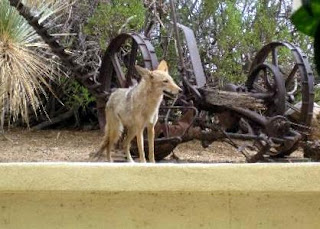
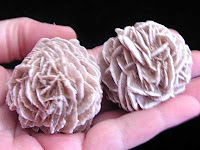 Adrian showed us some selenite rose rocks, and at one point we stopped and all got off the bus to roam some nearby sand dunes looking for these formations. I do not remember anyone finding a rose rock, but a group did see a rattlesnake, which disappeared into the scrubby desert plants. Intrepid Jared tracked the snake down, however, and took the photo below, instantly emailing it to me from his cell phone. Jared sat in the seat across the aisle from me and his English was as excellent as his brother's, so we conversed as though seat partners.
Adrian showed us some selenite rose rocks, and at one point we stopped and all got off the bus to roam some nearby sand dunes looking for these formations. I do not remember anyone finding a rose rock, but a group did see a rattlesnake, which disappeared into the scrubby desert plants. Intrepid Jared tracked the snake down, however, and took the photo below, instantly emailing it to me from his cell phone. Jared sat in the seat across the aisle from me and his English was as excellent as his brother's, so we conversed as though seat partners.
 All along the route, and each time we entered a city, there were large commemorative statues and obelisks in the center of roundabouts or at the side of the road. Many were for occasions or persons in Mexico’s War of Independence (Día de la Independencia), which, BTW, was being celebrated on the weekend the tour ended—although flags colored red, white, and green and decorations were up and some people had begun to celebrate early. Mexico celebrates Independence Day on September 16, the day Miguel Hidalgo is thought to have made the “cry of independence” (El Grito de la Independencia) in the town of Dolores, in Guanajuato state.
All along the route, and each time we entered a city, there were large commemorative statues and obelisks in the center of roundabouts or at the side of the road. Many were for occasions or persons in Mexico’s War of Independence (Día de la Independencia), which, BTW, was being celebrated on the weekend the tour ended—although flags colored red, white, and green and decorations were up and some people had begun to celebrate early. Mexico celebrates Independence Day on September 16, the day Miguel Hidalgo is thought to have made the “cry of independence” (El Grito de la Independencia) in the town of Dolores, in Guanajuato state. 
 In 1923, Villa was assassinated in his Dodge Brothers touring car (photo right and below) in Parral, Chihuahua, leaving 31-year-old Luz Villa a widow—and with an orphanage on their property of some 50 children of all ages, five or six the result of her husband’s extramarital activities. (Villa’s “exuberant machismo” claimed at least 26 women as “wife” during his lifetime but he was only legally married in the Catholic Church to Luz.) However, until her death in 1981, Luz celebrated her husband’s legacy—and her own celebrity—by turning her 50-room mansion into the Villa Museum. Ironically, today the Mexican military owns the property and the Historical Museum of the Revolution.
In 1923, Villa was assassinated in his Dodge Brothers touring car (photo right and below) in Parral, Chihuahua, leaving 31-year-old Luz Villa a widow—and with an orphanage on their property of some 50 children of all ages, five or six the result of her husband’s extramarital activities. (Villa’s “exuberant machismo” claimed at least 26 women as “wife” during his lifetime but he was only legally married in the Catholic Church to Luz.) However, until her death in 1981, Luz celebrated her husband’s legacy—and her own celebrity—by turning her 50-room mansion into the Villa Museum. Ironically, today the Mexican military owns the property and the Historical Museum of the Revolution.


 On the bus trip up to the hotel, Jared and I worked hard to identify the yellow flowers that filled the fields and lined the roadsides. It was close to impossible from the bus, but I picked a sample when we got to Divisadero, and we found the flower in one of Adrian's booklets. No scientific name, just a descriptor, something like "golden button flower" next to a photo of an "Unnamed Flower." I am nothing if not persistent, however, so tracked it down as possibly being one of two flowers: Tansy (Tanacetum vulgare) or Pericome (Pericome caudata). Both flowers are perennials of the aster family. Though beautiful along the roadsides,Tansy, an invasive herb, is poisonous, and is often used as a natural bug repellent. Pericome is descrbed on my Wildflower app as "a common late season wildflower along mountain road banks." Pericome was called Yerba de Chivato (the herb of the he-goat) by early Spaniards because of its odor. The sample I picked did not seem to have a strong odor, so maybe neither of these flowers is the one we were seeing so profusely along the roadside, though my money is still on Tansy.
On the bus trip up to the hotel, Jared and I worked hard to identify the yellow flowers that filled the fields and lined the roadsides. It was close to impossible from the bus, but I picked a sample when we got to Divisadero, and we found the flower in one of Adrian's booklets. No scientific name, just a descriptor, something like "golden button flower" next to a photo of an "Unnamed Flower." I am nothing if not persistent, however, so tracked it down as possibly being one of two flowers: Tansy (Tanacetum vulgare) or Pericome (Pericome caudata). Both flowers are perennials of the aster family. Though beautiful along the roadsides,Tansy, an invasive herb, is poisonous, and is often used as a natural bug repellent. Pericome is descrbed on my Wildflower app as "a common late season wildflower along mountain road banks." Pericome was called Yerba de Chivato (the herb of the he-goat) by early Spaniards because of its odor. The sample I picked did not seem to have a strong odor, so maybe neither of these flowers is the one we were seeing so profusely along the roadside, though my money is still on Tansy. On the bus trip up to the hotel, Jared and I worked hard to identify the yellow flowers that filled the fields and lined the roadsides. It was close to impossible from the bus, but I picked a sample when we got to Divisadero, and we found the flower in one of Adrian's booklets. No scientific name, just a descriptor, something like "golden button flower" next to a photo of an "Unnamed Flower." I am nothing if not persistent, however, so tracked it down as possibly being one of two flowers: Tansy (Tanacetum vulgare) or Pericome (Pericome caudata). Both flowers are perennials of the aster family. Though beautiful along the roadsides,Tansy, an invasive herb, is poisonous, and is often used as a natural bug repellent. Pericome is descrbed on my Wildflower app as "a common late season wildflower along mountain road banks." Pericome was called Yerba de Chivato (the herb of the he-goat) by early Spaniards because of its odor. The sample I picked did not seem to have a strong odor, so maybe neither of these flowers is the one we were seeing so profusely along the roadside, though my money is still on Tansy.
On the bus trip up to the hotel, Jared and I worked hard to identify the yellow flowers that filled the fields and lined the roadsides. It was close to impossible from the bus, but I picked a sample when we got to Divisadero, and we found the flower in one of Adrian's booklets. No scientific name, just a descriptor, something like "golden button flower" next to a photo of an "Unnamed Flower." I am nothing if not persistent, however, so tracked it down as possibly being one of two flowers: Tansy (Tanacetum vulgare) or Pericome (Pericome caudata). Both flowers are perennials of the aster family. Though beautiful along the roadsides,Tansy, an invasive herb, is poisonous, and is often used as a natural bug repellent. Pericome is descrbed on my Wildflower app as "a common late season wildflower along mountain road banks." Pericome was called Yerba de Chivato (the herb of the he-goat) by early Spaniards because of its odor. The sample I picked did not seem to have a strong odor, so maybe neither of these flowers is the one we were seeing so profusely along the roadside, though my money is still on Tansy.





 When all had returned on the tram, we were given the choice of walking back to the hotel (about 2 miles) or riding on the little zoo-type train. I chose to walk. I took several photos along the way ("Bonsai" tree on a pinnacle of rock, left) and enjoyed myself except when a member of the group posed for a photo at the very edge of the canyon. I have such acrophobia that I cannot bear to even see someone close to a drop like that. When in view of the lodge, the trail turned to a swinging suspension bridge. Fortunately for me there was a trail around it.
When all had returned on the tram, we were given the choice of walking back to the hotel (about 2 miles) or riding on the little zoo-type train. I chose to walk. I took several photos along the way ("Bonsai" tree on a pinnacle of rock, left) and enjoyed myself except when a member of the group posed for a photo at the very edge of the canyon. I have such acrophobia that I cannot bear to even see someone close to a drop like that. When in view of the lodge, the trail turned to a swinging suspension bridge. Fortunately for me there was a trail around it. The Rarámuri, or Tarahumara, are an indigenous people living in northwestern Mexico and known for their long-distance running ability. The Spanish named them Tarahumara. Their word for themselves, Rarámuri, means “runners on foot” or “those who run fast.” Because they are a shy people and do not live in large communities, these people developed a tradition of non-stop, long-distance running through their home area of rough canyon country for communication, transportation, and hunting. They run barefoot or in huaraches made of animal skin, or today, made from the rubber of discarded tires. Running is a joy for these people. One Tarahumara ran 400 miles non-stop in a little over 50 hours! Sounds impossible, but it is true. Astonishingly, every individual in the entire tribe—men, women, old, and young—is capable of running great distances in a single run. Such an extreme feat of endurance has never been seen among humans anywhere else in the world. The Tarahumara also practice persistence hunting of deer and wild turkeys, following them at a steady pace for one or two days until the animal drops from exhaustion.
The Rarámuri, or Tarahumara, are an indigenous people living in northwestern Mexico and known for their long-distance running ability. The Spanish named them Tarahumara. Their word for themselves, Rarámuri, means “runners on foot” or “those who run fast.” Because they are a shy people and do not live in large communities, these people developed a tradition of non-stop, long-distance running through their home area of rough canyon country for communication, transportation, and hunting. They run barefoot or in huaraches made of animal skin, or today, made from the rubber of discarded tires. Running is a joy for these people. One Tarahumara ran 400 miles non-stop in a little over 50 hours! Sounds impossible, but it is true. Astonishingly, every individual in the entire tribe—men, women, old, and young—is capable of running great distances in a single run. Such an extreme feat of endurance has never been seen among humans anywhere else in the world. The Tarahumara also practice persistence hunting of deer and wild turkeys, following them at a steady pace for one or two days until the animal drops from exhaustion.

 Today, some Tarahumara beg (left), but many more support themselves through the tourist trade, making and selling artisan grass and pine needle baskets, carved bark animals, jewelry, and woven shawls, among other wares. We were encouraged not to give money to those begging but to respect their dignity by buying their handicrafts. So, after breakfast, I readied my suitcase and put it outside our door for the porter, and then spent most of the morning buying trinkets from and photographing the Tarahumara who had set up their tables in the parking lot beside the hotel and also on the both sides of the covered walkway up to the train station. Most of the male Tarahumaras that I saw wore jeans, tees and ball caps, but the women were dressed more traditionally and wore colorful gathered skirts, kerchiefs, and shawls, but also modern long-sleeved tops, socks, and shoes.
Today, some Tarahumara beg (left), but many more support themselves through the tourist trade, making and selling artisan grass and pine needle baskets, carved bark animals, jewelry, and woven shawls, among other wares. We were encouraged not to give money to those begging but to respect their dignity by buying their handicrafts. So, after breakfast, I readied my suitcase and put it outside our door for the porter, and then spent most of the morning buying trinkets from and photographing the Tarahumara who had set up their tables in the parking lot beside the hotel and also on the both sides of the covered walkway up to the train station. Most of the male Tarahumaras that I saw wore jeans, tees and ball caps, but the women were dressed more traditionally and wore colorful gathered skirts, kerchiefs, and shawls, but also modern long-sleeved tops, socks, and shoes.







 As we descended from the top of the Sierra Madre into the canyon, the pine forests gave way to oaks, cottonwoods, madrone, and balsa trees with manzanita bushes, saguaro, cholla, and ocotillo cactus mixed in. The cacti, particularly the organ pipe cacti, grew among the deciduous trees. I had never seen such a surprising mix. The sheer rock faces of the canyon became rolling hills and tropical farmlands. Palm, banana, papaya, and mango trees began to dot the landscape. Often Crested Caracaras, the bird depicted on the National Emblem of Mexico, and Black Vultures, their wings outstretched to catch the sun, perched atop organ pipe cacti; and quite a few saguaro cacti sported nest holes drilled by Gila Woodpeckers (above).
As we descended from the top of the Sierra Madre into the canyon, the pine forests gave way to oaks, cottonwoods, madrone, and balsa trees with manzanita bushes, saguaro, cholla, and ocotillo cactus mixed in. The cacti, particularly the organ pipe cacti, grew among the deciduous trees. I had never seen such a surprising mix. The sheer rock faces of the canyon became rolling hills and tropical farmlands. Palm, banana, papaya, and mango trees began to dot the landscape. Often Crested Caracaras, the bird depicted on the National Emblem of Mexico, and Black Vultures, their wings outstretched to catch the sun, perched atop organ pipe cacti; and quite a few saguaro cacti sported nest holes drilled by Gila Woodpeckers (above). Copper Canyon is a group of six canyons formed by six rivers that later merge to form the Rio Fuerte that drains into the Sea of Cortez. At the bottom of the canyon we followed one of these rivers that I think Adrian said was the San Pedro River, sometimes at near river level and other times high above it. At one point I saw a flock of 15 or so mid-sized black birds with white wing patches flying above the river below. I believe that these were Phainopeplas.
Copper Canyon is a group of six canyons formed by six rivers that later merge to form the Rio Fuerte that drains into the Sea of Cortez. At the bottom of the canyon we followed one of these rivers that I think Adrian said was the San Pedro River, sometimes at near river level and other times high above it. At one point I saw a flock of 15 or so mid-sized black birds with white wing patches flying above the river below. I believe that these were Phainopeplas. Our Hotel La Choza was modest looking from the outside but wonderful when one entered its courtyard. As far as I could determine with my limited Spanish, this hotel's name means "The Hut" or "Shack." It was anything but and would be our home for the next two nights. Nancy's and my room was on the second floor, had a beamed ceiling and a crucifixion on the wall. We cranked up the AC as the outdoor temps in this tropical city were in the low 100s with high humidity, quite a change from the cool breezy canyon rim..
Our Hotel La Choza was modest looking from the outside but wonderful when one entered its courtyard. As far as I could determine with my limited Spanish, this hotel's name means "The Hut" or "Shack." It was anything but and would be our home for the next two nights. Nancy's and my room was on the second floor, had a beamed ceiling and a crucifixion on the wall. We cranked up the AC as the outdoor temps in this tropical city were in the low 100s with high humidity, quite a change from the cool breezy canyon rim..


 From the bus today we saw many parents walking their children to school as well as street dogs and smog over the cities we drove through. The fencing in one town was creative-- a gate made of bicycles and a fence made of stacked rocks in a wire frame. Each village we pass through has "sleeping policemen" and signs warning of these speed bumps. The sign looks something like a bra (see the top image in the picture left). Before one village some pranksters had added nipples to the humps, turning the "bra" into breasts. Elois navigated these speed humps carefully in the big bus.
From the bus today we saw many parents walking their children to school as well as street dogs and smog over the cities we drove through. The fencing in one town was creative-- a gate made of bicycles and a fence made of stacked rocks in a wire frame. Each village we pass through has "sleeping policemen" and signs warning of these speed bumps. The sign looks something like a bra (see the top image in the picture left). Before one village some pranksters had added nipples to the humps, turning the "bra" into breasts. Elois navigated these speed humps carefully in the big bus.  It was heating up and there was no tree cover at the site, so I opened the umbrella that Mayflower Tours had sent me. This was the only time I used it on the tour as the rainy season had occurred prior to our arrival and all stops but El Fuerte were in cool breezy areas. Before taking the trail to the digs and restoration we walked in the museum's desert garden where we saw the usual ocotillo, cholla, agave, and yucca. On one of the agave plants was a very large black-and-yellow grasshopper(see below).
It was heating up and there was no tree cover at the site, so I opened the umbrella that Mayflower Tours had sent me. This was the only time I used it on the tour as the rainy season had occurred prior to our arrival and all stops but El Fuerte were in cool breezy areas. Before taking the trail to the digs and restoration we walked in the museum's desert garden where we saw the usual ocotillo, cholla, agave, and yucca. On one of the agave plants was a very large black-and-yellow grasshopper(see below).


















